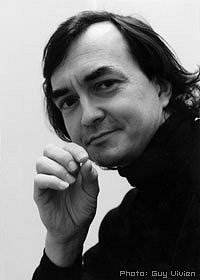S & H Concert Review
Berlioz, Beethoven, Ravel, Charles Dutoit, Pierre-Laurent Aimard, Philharmonia Orchestra, London Philharmonic Chorus; 22nd February 2003 RFH (AR)
Charles Dutoit opened his Philharmonia Orchestra concert with a pristine performance of Berlioz’s popular Le Carnival Romain Overture. This overture is frequently bashed out as a spectacular showcase for the orchestra, but under Dutoit’s sensitive baton we seemed to hear the work afresh, without the customary bombast. The conductor’s tempi were daringly broad and his orchestral shadings were subtle, even restrained, allowing a clarity and transparency of orchestral textures to shine through. All the sections of the Philharmonia were on top form, responding to their conductor with precision and style.
Martha Argerich was to have performed Beethoven’s 1st Piano Concerto but cancelled due to a family bereavement. Pierre-Laurent Aimard, (winner of the 1st prize at the 1973 Messiaen Competition photo) was far from a mere substitute for his playing of this Concerto was revelatory. Whilst I have heard many performances of this work, never have I heard a rendition which so well brought out the humour and jollity of Beethoven’s cheekiest concerto.The first movement was performed in an almost acrobatic manner, with Aimard utilizing his whole body to produce playing of the utmost vigour and dynamism. At the end of the cadenza Aimard made a humorous pause which brought a spontaneous outburst of laughter from the audience, as if the pianist were sharing a private joke between himself and Beethoven.
A change of mood in the Largo and Aimard produced a serene and eloquent sound, perfectly paced and delicately phrased, whilst in the Rondo: Allegro scherzando he displayed an agile athleticism, playing with great buoyancy and rhythmic bite. The concerto was dramatically rounded off with a firm flourish from Andrew Smith on timpani. Aimard’s stylish playing was perfectly complemented by sensitive support from the Philharmonia and conductor.
Dutoit’s reading of Ravel’s complete Daphnis et Chloé was reserved, restrained and clinically measured, somewhat sacrificing the sensuous and the sensational, the magical and the mysterious. However, Dutoit’s directness and objectivity, and concern for structure rather than sensation, gave the score a refreshing new lease of life, very similar to Ansermet and Monteux’s classical reading of this score. Dutoit’s reserve actually intensified the more climatic moments: he knew exactly when to hold back his forces and when to let them explode.
Sometimes the orchestra sounded almost stifled by Dutoit’s rather slow, surgical style of conducting: it was as if the players could not keep up with his broad tempi; ensemble was not always together and the performance on occasion was on a knife edge of collapsing and falling apart; but curiously this tension added to the excitement of this electrifying performance.
Ravel’s use of the wind machine in Danse lente et mystérieuse has always provided a somewhat unnecessarily kitsch element to the work, much akin to Strauss’ Alpine Symphony, and Wagner’s Die Valkure Act 1. Machinery – vacuum cleaners, typewriters etc. - worked brilliantly for Gerard Hoffnung, but that was intended to be funny.
The opening passages of Part 3, Lever du jour, were rather blurred, with very important interchanges between ‘cellos and double basses being barely audible; indeed, throughout this work the ‘cellos and double basses play a very important role in emphasising the breathing life-force pulse of this score, and all this was sadly lost.
Dutoit deliberately (and rightly) held back his forces until the closing passages of the Bacchanale, where the intensity and energy of the players ended the work in a frenzy of whirling, intoxicating sound. In the end, Dutoit’s civilised and manicured reading paid off, giving us a reading to relish and remember. This was Ravel restored like an old master painting, with all the old, discoloured varnish removed to reveal the original tones and hues frequently obscured by lesser conductors.
The London Philharmonic Chorus were on top form (as they were in Haitink’s recent Mahler 2nd Symphony) and their rendition of the atmospheric wordless chorus was one of the highlights of the evening. However, chief honours must go to Pierre-Laurent Aimard for his inspired playing.
Alex Russell
